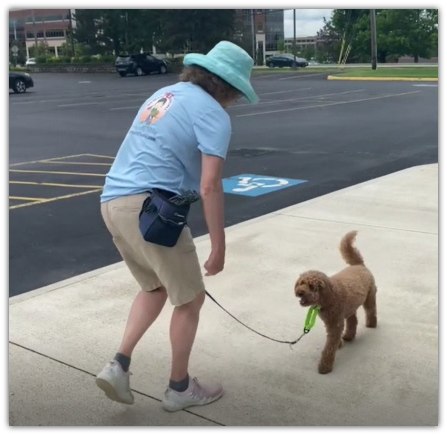There are times when you are practicing loose leash walking with your dog that you may need to change direction. One of my directional cues is “This Way.” It simply means, we are about to move backwards (or another direction) and I need for you to come with me. Below are some different reasons I may use it, how I teach it, and a video showing examples.
 In this example, “This Way” means I am now going to walk backwards and I want you to walk toward me. Then, I may turn my body to walk in another direction with you by my side.
In this example, “This Way” means I am now going to walk backwards and I want you to walk toward me. Then, I may turn my body to walk in another direction with you by my side.
Here are some reasons I may use it:
As part of the reinforcement delivery for walking on a loose leash. By making this a positive, fun change for the dog and having it happen as a result of walking on a loose leash, it can strengthen the behavior of walking with me.
To maintain connection with the dog. I can ask for This Way at any unexpected time.
To move away from something the dog will react to. If the dog I am walking is one that will bark/lunge/growl at other dogs, people, moving objects or something else, I may need to get distance from that trigger quickly.
To help practice calm greetings. I may want to keep the greeting short in the beginning because the longer the greeting lasts, the more potential there is for the dog’s arousal to heighten.
To transition from a sniffing break to walking ahead. I may also use a cue ‘Let’s Go’ for this. I use Let’s Go to mean we are stopping one activity (like being in a sit) to moving again.
How to teach it:
Practice in an environment where there will be minimal distractions. An empty parking lot or inside your home is often a good choice. Also, use high value treats.
With your dog on a loose leash on your side, begin by walking two or three steps forward, then turn so that you are facing your dog. You can use a food lure the first two or three times (however, if you do this, stop luring with food after a couple of repetitions).
Initially give your dog a marker (like saying ‘YES’ or ‘GOOD’ or clicking) as soon as your dog turns to move with you. Then deliver a treat. Walk backwards several steps delivering one treat after another.
From there, you can begin walking forward with your dog on your side. Or you can turn clockwise to walk forward with your dog at your side.
Practice this over and over until your dog fluidly changes direction to follow you when you walk backwards.
When your dog is doing this fluidly, then you can add the verbal cue of THIS WAY (or whatever cue you would like to use). Insert THIS WAY, just before you turn to face your dog. Then mark your dog for following you, and give reinforcement.
Again practice this over and over.
When your dog is easily moving direction with you, you can begin to practice with some distractions around you.







